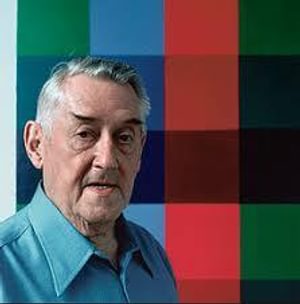Richard Paul Lohse
Richard Paul Lohse was a Swiss painter and graphic artist and a prime mover within the concrete art movement there. Lohse was born in Zürich in 1902, and although he had ambitions to study art in Paris he lacked the resources to do so.
In 1918, he joined the advertising agency Max Dalang, where he trained to become an advertising designer. Self-taught, he painted expressive, cubist-like still lives. By the 1930s, his work as a graphic artist and book designer placed him among the pioneers of modern Swiss graphic design and his success eventually allowed him to establish his own graphic design studio in Zürich. In his paintings of this period, he worked on curved and diagonal constructions.
He combined art with a political and moral awareness, which led him to be an activist for immigrants. In the 1930s, he was actively involved in protests, which were illegal under the government of the time. He continued to protest until the beginning of World War II. His political convictions then led him into the resistance movement, where he met his future wife Ida Alis Dürner.
In 1937, Lohse co-founded Allianz, an association of Swiss modern artists, with Leo Leuppi. In 1938, he helped Irmgard Burchard, to whom he was married for a brief time, to organise the London exhibition "Twentieth Century German Art". The year 1943 marked a breakthrough in Lohse's painting, he started to develop modular and serial systems and after the war he participated in the exhibition "Tendencies in Abstract Art" at Galerie Denise René in Paris. In 1953, he published the book New Design in Exhibitions, and from 1958, he became co-editor of the magazine Neue Grafik.
In 1961 there was a retrospective exhibition of his work at the Stedelijk Museum, Amsterdam, and in 1971 at the Moderna Museet, Stockholm.
Available works by Richard Paul Lohse
Available Artists
- Albers Anni
- Andre Carl
- Avery Milton
- Baldessari John
- Bell Larry
- Brice Lisa
- Crawford Brett
- Dadamaino
- Dávila Jose
- de Tollenaere Saskia
- Downing Thomas
- Dyson Julian
- Francis Sam
- Freud Lucian
- Gadsby Eric
- Gander Ryan
- Guston Philip
- Haring Keith
- Held Al
- Hockney David
- Hui Zhang
- Kapoor Anish
- Katz Alex
- Kelly Ellsworth
- Knifer Julije
- Kusama Yayoi
- Le Parc Julio
- Leciejewski Edgar
- Léger Fernand
- Levine Chris
- LeWitt Sol
- Lichtenstein Roy
- Maripol
- Martin Agnes
- Martin Jason
- Martin Kenneth
- Mavignier Almir da Silva
- Miller Harland
- Morellet François
- Motherwell Robert
- Nadelman Elie
- Nemours Aurélie
- O'Donoghue Hughie
- Pettibone Richard
- Picasso Pablo
- Prehistoric Objects
- Prince Richard
- Quinn Marc
- Riley Bridget
- Ruscha Ed
- Scott William
- Shrigley David
- Smith Anj
- Smith Richard
- Smith David
- Sonnier Keith
- Soto Jesús Rafael
- Soulages Pierre
- Taller Popular de Serigrafía
- The Connor Brothers
- Turk Gavin
- Vasarely Victor
- Warhol Andy
- Wesselmann Tom
- Wood Jonas
- Wool Christopher
